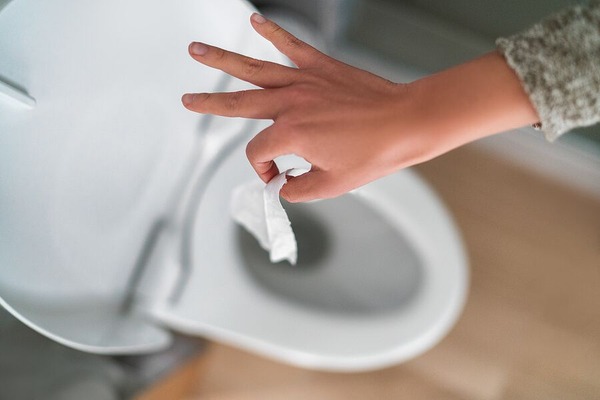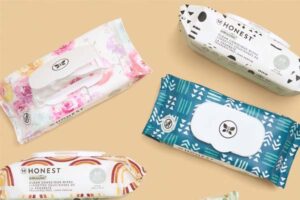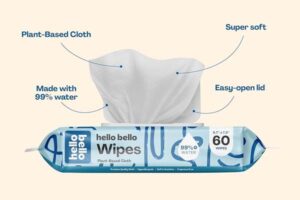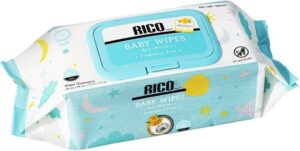
Are you confused about flushing water wipes? Many people are, and a wrong move can lead to big plumbing problems. Let's clear this up so you can dispose of wipes correctly.
No, most water wipes are not flushable1. They don't break down in water like toilet paper. Flushing them can cause serious clogs in your pipes and city sewer systems.
The term "flushable" on wipe packaging can be very misleading. Unlike toilet paper, which is specifically designed to disintegrate quickly when agitated in water, most wet wipes, including many labeled as "water wipes," are made from stronger materials. These materials often include non-woven fabrics made from plastics like polyester or polypropylene, or even durable natural fibers like cotton or viscose that don't break apart easily. Their job is to stay intact during use for effective cleaning. This strength, however, becomes a big problem when they enter plumbing systems. They can accumulate, mix with fats, oils, and grease, and form massive blockages known as "fatbergs" in municipal sewers.
So, why the confusion? Some manufacturers might claim their wipes are "flushable" based on passing certain industry tests, like those developed by INDA/EDANA. These tests often assess if a wipe can clear a toilet bowl and drain line under lab conditions. However, these conditions don't always replicate real-world sewer systems, especially older ones, or septic tanks. Furthermore, the speed of breakdown is critical. Toilet paper dissolves within minutes. Many "flushable" wipes take much longer, if they break down significantly at all. Always err on the side of caution: unless a wipe is explicitly certified by local wastewater authorities (like the "Fine to Flush" certification in the UK), it's best to dispose of it in the trash.
Are water wipes biodegradable?
Many people think "water wipes" sound natural and eco-friendly. So, they must break down easily in the environment, right? Let's explore if water wipes are truly biodegradable2.
Some water wipes can be biodegradable if made from 100% plant-based fibers like cotton, bamboo, or viscose. However, "biodegradable" doesn't mean flushable or compostable in all conditions. Always check the material composition and certifications.

When we talk about biodegradability, we're referring to a material's ability to be broken down by bacteria, fungi, or other microorganisms into natural elements like water, carbon dioxide, and biomass. The key factors here are the material itself, the environment it's in, and the time it takes.
What Makes a Wipe Biodegradable?
The core material of the wipe is the main decider.
- Plant-Based Fibers: Materials such as 100% cotton, bamboo viscose, lyocell (Tencel™), and Polylactic Acid (PLA) non-wovens (derived from corn starch or sugarcane) are generally biodegradable under the right conditions. At BBWIPES®, we specialize in using these types of sustainable materials for our clients who prioritize eco-friendliness. For example, our 100% organic cotton and bamboo viscose options are designed for optimal biodegradability.
- Synthetic Fibers: Wipes made with plastic fibers like polyester (PET) or polypropylene (PP) are not biodegradable. They can persist in the environment for hundreds of years, eventually breaking down into microplastics, which are a significant pollution concern.
Here's a quick look at common wipe materials:
| Material | Biodegradable? | Common Source | Notes |
|---|---|---|---|
| Polyester (PET) | No | Synthetic (Plastic) | Persists in environment, forms microplastics |
| Polypropylene (PP) | No | Synthetic (Plastic) | Persists in environment, forms microplastics |
| Cotton | Yes (if 100% & untreated) | Plant-based | Widely available, can be organic |
| Bamboo Viscose | Yes | Plant-based (Bamboo) | Soft, strong, renewable resource |
| Lyocell (Tencel™) | Yes | Plant-based (Wood pulp) | Closed-loop production, very sustainable |
| PLA Non-woven | Yes (under industrial composting) | Plant-based (Corn/Sugar) | Requires specific conditions to break down |
Biodegradable vs. Compostable
It's important to understand that "biodegradable" is not the same as "compostable."
- Biodegradable: Will break down naturally over time, but this can be a long period, and the conditions are not always specified.
- Compostable: Will break down in a composting environment (home or industrial) within a specific timeframe (e.g., 90-180 days), typically turning into humus, which can benefit soil. Industrial composting requires higher temperatures than a home compost bin.
Many biodegradable wipes are not suitable for home composting and may require industrial composting facilities, which aren't available everywhere.
Certifications to Look For
Genuine biodegradable or compostable claims are often backed by third-party certifications. These provide assurance that the product has been tested and meets specific standards. Examples include:
- TÜV Austria (OK compost HOME, OK compost INDUSTRIAL, OK biodegradable SOIL/WATER): Internationally recognized certifications.
- BPI (Biodegradable Products Institute): North American certification for compostability.
- EU Ecolabel: Indicates products with a lower environmental impact throughout their lifecycle.
- FSC (Forest Stewardship Council): Ensures that wood-based materials (like viscose or lyocell) come from responsibly managed forests.
At BBWIPES®, we help clients like Henrik Sørensen, who prioritize sustainability, by sourcing materials that meet strict environmental criteria, including options for Cradle-to-Cradle certified materials when requested.
What are the ingredients in water wipes3?
You see "water wipes" on the label and think, "It's just water, right?" While that's mostly true, there's usually a little more to it. Let's look at what's really inside.
True water wipes are predominantly purified water, often over 99%. The remaining small percentage usually includes a gentle fruit extract (like grapefruit seed extract) or a mild preservative to keep the wipes fresh and prevent microbial contamination.

The appeal of water wipes is their simplicity, making them a popular choice for sensitive skin, especially for babies. The goal is to cleanse effectively with minimal ingredients to reduce the risk of irritation.
The Role of Water
The primary ingredient is, indeed, water. But it's not just tap water. Manufacturers typically use:
- Purified Water: Water that has undergone processes like deionization, reverse osmosis, or distillation to remove impurities, minerals, and potential irritants. This ensures consistency and gentleness.
Why Not Just 100% Water?
If the goal is simplicity, why add anything else?
- Preservation: Pure water, especially once a package is opened and exposed to air and hands, can become a breeding ground for bacteria, yeast, and mold. A very small amount of preservative is crucial to ensure the wipes stay safe to use from the first to the last.
- Skin Conditioning (Sometimes): Some formulations might include a trace amount of a skin-conditioning agent, often derived from fruit, to provide a slight soothing effect.
- pH Balance: Sometimes, a pH adjuster is used to ensure the wipe solution is close to the natural pH of the skin, further minimizing potential irritation.
Common Gentle Additives (The <1% Crew)
These are typically found in very low concentrations, often less than 1% of the total formula.
| Ingredient Name(s) | Purpose | Why it's Used |
|---|---|---|
| Aqua (Water) | Primary cleansing agent, solvent | The main component |
| Citrus Grandis (Grapefruit) Seed Extract | Natural preservative properties, sometimes skin conditioning | A common 'natural' preservative choice |
| Sodium Benzoate | Food-grade preservative | Prevents growth of bacteria, yeast, and mold |
| Potassium Sorbate | Food-grade preservative | Often used with sodium benzoate for broad protection |
| Citric Acid / Sodium Citrate | pH adjuster | Helps maintain a skin-friendly pH level |
| Benzalkonium Chloride | Antiseptic/Preservative | More common in antibacterial wipes, less in pure 'water' wipes, provides antimicrobial action |
| Glycerin | Humectant | Helps skin retain moisture (less common in basic water wipes) |
At BBWIPES®, we understand the need for pure and gentle formulations. For clients like Emily Thompson, who need clinically validated products for healthcare, or Luca Moretti, seeking organic ingredients for luxury skincare, we offer custom formulation expertise. We can create wipes with minimal, carefully selected ingredients, like the pH-balanced antiseptic wipes we co-engineered for a US Pediatric Hospital Network. We also offer options like our alcohol-free sanitizing wipes using Citridiol® technology, for effective yet gentle cleansing. Our R&D labs ensure that even the simplest formulations are stable, safe, and meet regulatory standards like EU Cosmetics Regulation 1223/2009.
Why Choose BBWIPES® for Your Wet Wipe Needs?
Choosing the right manufacturing partner is key to your brand's success. At BBWIPES®, we're more than just a supplier; we're your partner in creating high-quality wet wipe solutions.
With over 12 years of experience, our Wenzhou, China facility is ISO 9001, GMP, and ISO 22716 certified. We operate 4 fully automated production lines with a capacity of over 100,000 packs per month, ready to scale up during peak seasons.
Here's what sets us apart:
- Vertical Integration & Custom Formulation: We manage the process from raw material selection (like 100% organic cotton, bamboo viscose, or PLA non-woven) to engineering biodegradable fibers, fragrance infusion, and moisture-lock packaging. Our R&D labs can develop custom solutions, from alcohol-free sanitizing wipes with Citridiol® to hypoallergenic baby care. We pioneered "AquaRise®" technology, using 30% less liquid while maintaining 99.9% efficacy.
- Industry-Specific Expertise: We create tailored solutions for diverse sectors. For a French Luxury Hotel Chain, we developed rosewater-infused facial wipes, cutting their toiletry costs by 40% and achieving 92% CSR satisfaction. For a US Pediatric Hospital Network, we co-engineered pH-balanced antiseptic wipes that passed FDA 510(k) clearance in just 11 weeks.
- Global Logistics & Regulatory Mastery: We export 85% of our products to the USA, Russia, France, and the UK. Our team handles temperature-controlled shipping and DDP/DAP terms, ensuring a 12-day standard lead time. Our pre-approved formulations meet EU Cosmetics Regulation 1223/2009 and US EPA criteria, and we provide GHS-compliant SDS documentation.
- Unwavering Quality Assurance: Our 4-Stage Inspection Protocol covers raw material screening (ISO 11737-1), in-line pH/absorbency checks, tensile strength validation (ASTM D5034), and final packaging seal integrity. We hold Cruelty-Free International Leaping Bunny and FSC-certified packaging sourcing.
- MOQ Flexibility & Client Support: We offer MOQs from 10,000 units for stock designs and 50,000 units for custom formulations. Our 24/7 lab support and free compatibility testing (3 prototype iterations included) ensure your project's success.
If you're like Priya Kapoor, looking for innovative CBD-infused wipes with nanoemulsion tech, or need consistent quality like Emily Thompson, we are equipped to meet your demands.
Conclusion
To sum up: most water wipes are not flushable and should be binned. Some are biodegradable if made from plant-based fibers. Their ingredients are mainly water, with tiny amounts of gentle preservatives. Always check labels carefully.
-
Understanding the term 'flushable' can help you avoid plumbing issues and make informed choices about wipe disposal. ↩
-
Exploring the truth behind biodegradable wipes can guide you in making sustainable choices for the environment. ↩
-
Knowing the ingredients in water wipes can help you choose safer options for sensitive skin, especially for babies. ↩







